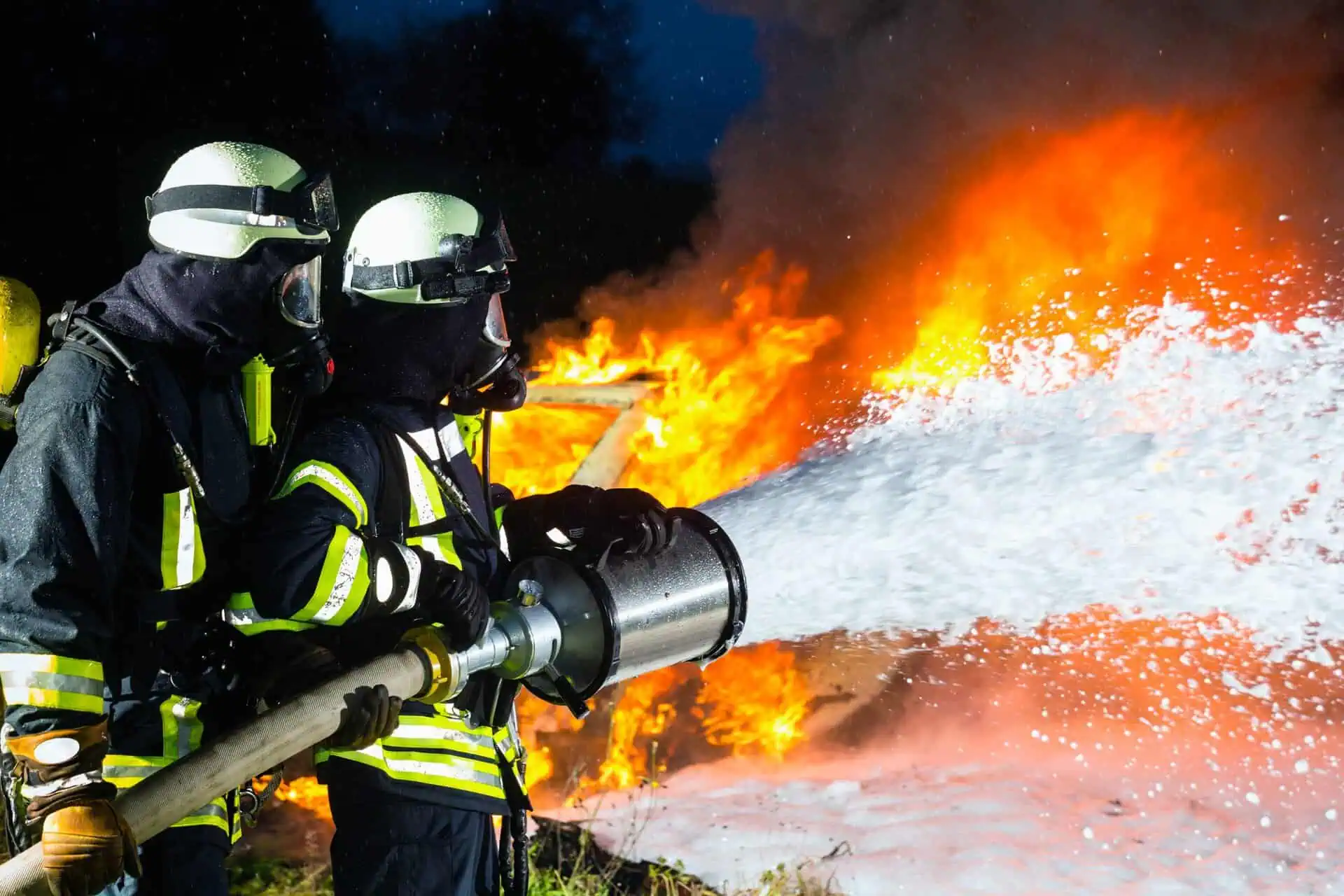The relationship between AFFF firefighting foam and pancreatic cancer centers on the dangerous PFAS chemicals contained within these fire suppressants.
Learning about both the composition of AFFF and the growing body of scientific research linking these toxic chemicals to pancreatic cancer provides the foundation for current litigation efforts.

As courts examine the evidence connecting AFFF exposure to various cancers, pancreatic cancer represents an emerging area of legal recognition with substantial implications for those who have developed this aggressive disease following firefighting foam exposure.
Learning About AFFF Firefighting Foam and PFAS Chemicals
Aqueous Film-Forming Foam (AFFF) represents a highly effective firefighting suppressant developed in the early 1960s through collaboration between the U.S. Navy and 3M Corporation.
Originally designed to combat high-heat petroleum-based fires, AFFF became the standard fire suppression method for military installations, airports, and civilian fire departments worldwide.
The composition and widespread adoption of AFFF typically include:
- PFAS Chemical Content: AFFF concentrates contain up to 15-18% surfactants, with synthetic chemicals making up the active ingredients that create the film-forming properties.
- Historical Usage Timeline: 3M served as the sole supplier from the mid-1960s until 1973, with the U.S. Navy requiring AFFF on all vessels by the late 1960s.
- Military Implementation: The Department of Defense (including the US Air Force) began widespread AFFF deployment at all military installations throughout the 1970s.
- Commercial Availability: AFFF is sold as concentrates in 1%, 3%, and 6% ratios for mixing with water during firefighting operations.
- PFAS Persistence: These “forever chemicals” do not readily decompose in the environment and remain biologically persistent in the human body.
The effectiveness of AFFF in suppressing fuel fires made it an indispensable tool across military and civilian applications.
However, the same PFAS chemicals that provide AFFF’s fire-suppressing capabilities also pose serious health risks to those exposed during training exercises, actual firefighting operations, and through environmental contamination.
If you or a loved one developed pancreatic cancer after exposure to AFFF firefighting foam, you may be eligible to seek compensation.
Contact TruLaw using the chat on this page to receive an instant case evaluation and determine whether you qualify to file an AFFF lawsuit today.
Scientific Studies Linking PFAS Exposure to Pancreatic Cancer
Recent scientific research has established concerning connections between PFAS exposure from AFFF and pancreatic cancer development.
The 2022 study published in Gastrointestinal Cancer Research demonstrated that perfluorooctanoic acid (PFOA), a primary component of AFFF, leads directly to pancreatic cancer promotion in laboratory studies.
Research findings linking PFAS to pancreatic cancer commonly feature:
- Oxidative Stress Induction: PFOA exposure triggers substantial oxidative stress in pancreatic tissues, creating cellular damage that can lead to cancer development
- Dose-Response Analysis: Researchers observed pancreatic tumor development even at extremely low PFOA concentrations, suggesting current Environmental Protection Agency health advisory levels may be inadequate
- Inflammatory Response: PFAS chemicals induce pro-inflammatory cytokines and increase reactive oxygen species production in human cells
- Cellular Mechanism: Studies show PFAS disrupts normal cellular processes and damages proteins, lipids, and DNA within pancreatic tissues
- Environmental Persistence: Unlike other toxins, PFAS accumulate in the body over time, creating prolonged exposure effects that increase cancer risk
The Indiana University School of Medicine research revealed that individuals with prolonged exposure to PFAS-contaminated drinking water showed higher incidences of chronic pancreatitis, a well-documented precursor to pancreatic cancer.
Additional studies from the National Cancer Institute have identified associations between several PFAS chemicals and various cancer types, with pancreatic cancer emerging as a major concern alongside prostate cancer and other malignancies.
Dose-response analysis conducted by researchers suggests that the lifetime human exposure limit for PFOA should be approximately 700 times lower than current EPA health advisory levels.
This finding indicates that even minimal AFFF exposure may pose substantial pancreatic cancer risks, particularly for individuals with occupational or environmental exposure over extended periods.
Why Pancreatic Cancer Cases Are Being Added to AFFF Litigation
The AFFF multidistrict litigation currently recognizes six specific conditions associated with PFAS exposure: kidney cancer, testicular cancer, ulcerative colitis, thyroid disease, thyroid cancer, and liver cancer.
However, AFFF firefighting foam cases involving pancreatic cancer are gaining substantial momentum within the legal proceedings as scientific evidence continues to strengthen.
Current developments in pancreatic cancer recognition often involve:
- Science Days Scheduling: The court has scheduled two Science Days for June 2025, with the second session on June 20th specifically focusing on research linking PFAS exposure to various cancers
- Judicial Review Process: Judge Richard M. Gergel is evaluating additional scientific evidence to determine whether pancreatic cancer should join the recognized conditions list
- Growing Case Volume: Legal experts anticipate AFFF cancer lawsuits will include pancreatic cancer cases in settlement negotiations as the scientific discussion evolves within the MDL framework
- Advocacy Efforts: Firefighting foam attorneys representing AFFF victims are actively presenting pancreatic cancer research to support inclusion in future bellwether trials
- Timeline Expectations: Legal analysts project pancreatic cancer recognition may occur within 12-18 months based on ongoing scientific presentations
The AFFF MDL, consolidated in the U.S. District Court for the District of South Carolina, currently includes over 6,000 pending cases.
As the scientific evidence supporting pancreatic cancer causation continues to mount, these cases represent an emerging area of substantial legal opportunity for affected individuals.
Manufacturers including 3M, Tyco Fire Products, and other defendants have made multiple attempts to dismiss AFFF claims, but the AFFF firefighting foam litigation remains active and is proceeding.
The upcoming Science Days will provide opportunities for comprehensive scientific presentations that may influence the court’s decisions regarding pancreatic cancer inclusion in settlement discussions.
If you or a loved one suffered pancreatic cancer following AFFF firefighting foam exposure, you may be eligible to file an AFFF firefighting foam lawsuit.
Contact TruLaw using the chat on this page to receive an instant case evaluation and determine whether you qualify to join others in filing an AFFF lawsuit today.






